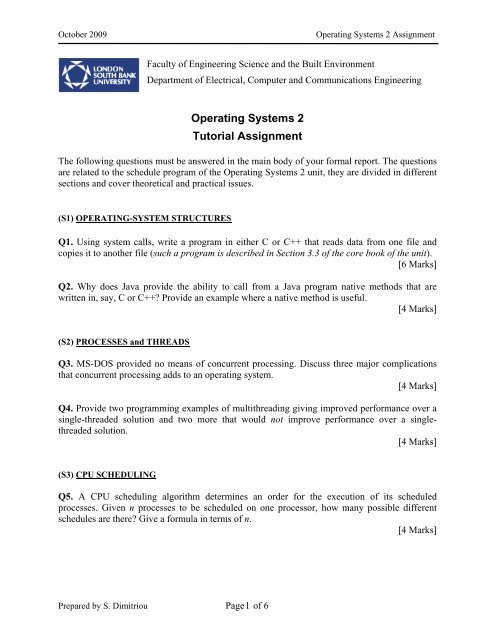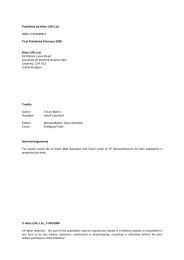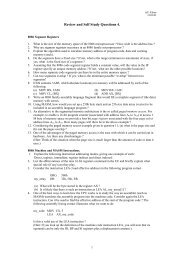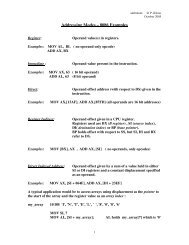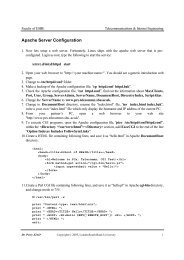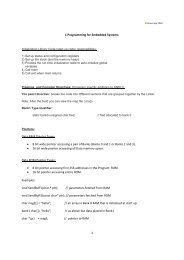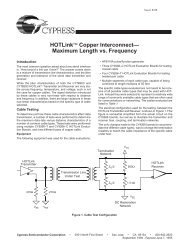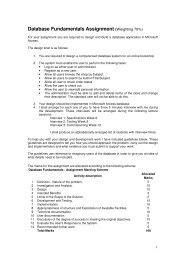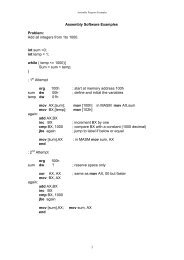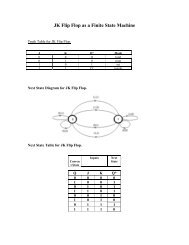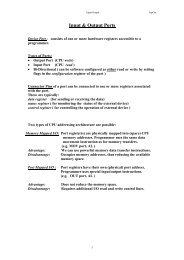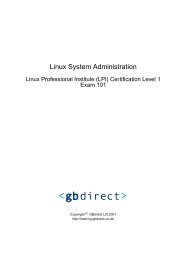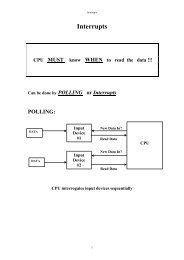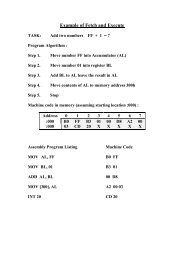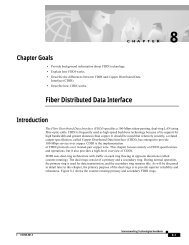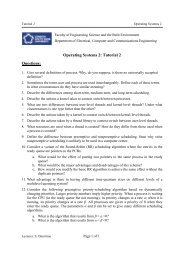Operating Systems 2 Tutorial Assignment
Operating Systems 2 Tutorial Assignment
Operating Systems 2 Tutorial Assignment
Create successful ePaper yourself
Turn your PDF publications into a flip-book with our unique Google optimized e-Paper software.
October 2009<br />
<strong>Operating</strong> <strong>Systems</strong> 2 <strong>Assignment</strong><br />
Faculty of Engineering Science and the Built Environment<br />
Department of Electrical, Computer and Communications Engineering<br />
<strong>Operating</strong> <strong>Systems</strong> 2<br />
<strong>Tutorial</strong> <strong>Assignment</strong><br />
The following questions must be answered in the main body of your formal report. The questions<br />
are related to the schedule program of the <strong>Operating</strong> <strong>Systems</strong> 2 unit, they are divided in different<br />
sections and cover theoretical and practical issues.<br />
(S1) OPERATING-SYSTEM STRUCTURES<br />
Q1. Using system calls, write a program in either C or C++ that reads data from one file and<br />
copies it to another file (such a program is described in Section 3.3 of the core book of the unit).<br />
[6 Marks]<br />
Q2. Why does Java provide the ability to call from a Java program native methods that are<br />
written in, say, C or C++? Provide an example where a native method is useful.<br />
[4 Marks]<br />
(S2) PROCESSES and THREADS<br />
Q3. MS-DOS provided no means of concurrent processing. Discuss three major complications<br />
that concurrent processing adds to an operating system.<br />
[4 Marks]<br />
Q4. Provide two programming examples of multithreading giving improved performance over a<br />
single-threaded solution and two more that would not improve performance over a singlethreaded<br />
solution.<br />
[4 Marks]<br />
(S3) CPU SCHEDULING<br />
Q5. A CPU scheduling algorithm determines an order for the execution of its scheduled<br />
processes. Given n processes to be scheduled on one processor, how many possible different<br />
schedules are there? Give a formula in terms of n.<br />
[4 Marks]<br />
Prepared by S. Dimitriou Page 1 of 6
October 2009<br />
<strong>Operating</strong> <strong>Systems</strong> 2 <strong>Assignment</strong><br />
Q6. Consider the following set of processes, with the length of the CPU-burst time given in<br />
milliseconds:<br />
Process Burst Time Priority<br />
P 1 10 3<br />
P 2 1 1<br />
P 3 2 3<br />
P 4 1 4<br />
P 5 5 2<br />
The processes are assumed to have arrived in the order P1, P2, P3, P4, P5, all at time 0.<br />
1. Draw four Gantt charts illustrating the execution of these processes using FCFS, SJF, a<br />
nonpreemptive priority (a smaller priority number implies a higher priority), and RR<br />
(quantum = 1) scheduling.<br />
2. What is the turnaround time of each process for each of the scheduling algorithms in part a?<br />
3. What is the waiting time of each process for each of the scheduling algorithms in part a?<br />
4. Which of the schedules in part a results in the minimal average waiting time (over all<br />
processes)?<br />
[6 Marks]<br />
Q7. Suppose that the following processes arrive for execution at the times indicated. Each<br />
process will run the listed amount of time. In answering the questions, use nonpreemptive<br />
scheduling and base all decisions on the information you have at the time the decision must be<br />
made.<br />
Process Arrival Time Burst Time<br />
P 1 0.0 8<br />
P 2 0.4 4<br />
P 3 1.0 1<br />
1. What is the average turnaround time for these processes with the FCFS scheduling<br />
algorithm?<br />
2. What is the average turnaround time for these processes with the SJF scheduling algorithm?<br />
3. The SJF algorithm is supposed to improve performance, but notice that we chose to run<br />
process P1 at time 0 because we did not know that two shorter processes would arrive soon.<br />
Compute what the average turnaround time will be if the CPU is left idle for the first 1 unit<br />
and then SJF scheduling is used. Remember that processes P1 and P2 are waiting during this<br />
idle time, so their waiting time may increase. This algorithm could be known as futureknowledge<br />
scheduling.<br />
[6 Marks]<br />
Prepared by S. Dimitriou Page 2 of 6
October 2009<br />
<strong>Operating</strong> <strong>Systems</strong> 2 <strong>Assignment</strong><br />
(S4) PROCESS SYNCHRONIZATION<br />
Q8. What is the meaning of the term busy waiting? What other kinds of waiting are there in an<br />
operating system? Can busy waiting be avoided altogether? Explain your answer.<br />
[4 Marks]<br />
(S5) DEADLOCKS<br />
Q9. Consider a system consisting of m resources of the same type, being shared by n processes.<br />
Resources can be requested and released by processes only one at a time. Show that the system is<br />
deadlock-free if the following two conditions hold:<br />
1. The maximum need of each process is between 1 and m resources<br />
2. The sum of all maximum needs is less than m + n<br />
[6 Marks]<br />
(S6) MEMORY MANAGEMENT<br />
Q10. Given memory partitions of 100K, 500K, 200K, 300K, and 600K (in order), how would<br />
each of the First-fit, Best-fit, and Worst-fit algorithms place processes of 212K, 417K, 112K, and<br />
426K (in order)? Which algorithm makes the most efficient use of memory?<br />
[6 Marks]<br />
Q11. Consider a logical address space of eight pages of 1024 words each, mapped onto a<br />
physical memory of 32 frames.<br />
1. How many bits are there in the logical address?<br />
2. How many bits are there in the physical address?<br />
[4 Marks]<br />
Q12. Consider a paging system with the page table stored in memory.<br />
1. If a memory reference takes 200 nanoseconds, how long does a paged memory reference<br />
take?<br />
2. If we add associative registers, and 75 percent of all page-table references are found in the<br />
associative registers, what is the effective memory reference time? (Assume that finding a<br />
page-table entry in the associative registers takes zero time, if the entry is there.)<br />
[5 Marks]<br />
Prepared by S. Dimitriou Page 3 of 6
October 2009<br />
<strong>Operating</strong> <strong>Systems</strong> 2 <strong>Assignment</strong><br />
Q13. Consider the following segment table:<br />
Segment Base Length<br />
0 219 600<br />
1 2300 14<br />
2 90 100<br />
3 1327 580<br />
4 1952 96<br />
What are the physical addresses for the following logical addresses?<br />
1. 0,430<br />
2. 1,10<br />
3. 2,500<br />
4. 3,400<br />
5. 4,112<br />
[5 Marks]<br />
(S7) VIRTUAL MEMORY<br />
Q14. Assume we have a demand-paged memory. The page table is held in registers. It takes 8<br />
milliseconds to service a page fault if an empty page is available or the replaced page is not<br />
modified, and 20 milliseconds if the replaced page is modified. Memory access time is 100<br />
nanoseconds. Assume that the page to be replaced is modified 70 percent of the time. What is the<br />
maximum acceptable page-fault rate for an effective access time of no more than 200<br />
nanoseconds?<br />
[5 Marks]<br />
Q15. An operating system supports a paged virtual memory, using a central processor with a<br />
cycle time of 1 microsecond. It costs an additional 1 microsecond to access a page other than the<br />
current one. Pages have 1000words, and the paging device is a drum that rotates at 3000<br />
revolutions per minute and transfers 1 million words per second. The following statistical<br />
measurements were obtained from the system:<br />
• 1 percent of all instructions executed accessed a page other than the current page.<br />
• Of the instructions that accessed another page, 80 percent accessed a page already in memory.<br />
• When a new page was required, the replaced page was modified 50 percent of the time.<br />
Calculate the effective instruction time on this system, assuming that the system is running one<br />
process only, and that the processor is idle during drum transfers.<br />
[6 Marks]<br />
Prepared by S. Dimitriou Page 4 of 6
October 2009<br />
<strong>Operating</strong> <strong>Systems</strong> 2 <strong>Assignment</strong><br />
(S8) FILE-SYSTEM INTERFACE<br />
Q16. Consider a system that supports 5000 users. Suppose that you want to allow 4990 of these<br />
users to be able to access one file.<br />
1. How would you specify this protection scheme in UNIX?<br />
2. Could you suggest another protection scheme that can be used more effectively for this<br />
purpose than the scheme provided by UNIX?<br />
[4 Marks]<br />
(S9) I/O SYSTEMS<br />
Q17. Consider the following I/O scenarios on a single-user PC.<br />
1. A mouse used with a graphical user interface<br />
2. A tape drive on a multitasking operating system (assume no device preallocation is available)<br />
3. A disk drive containing user files<br />
4. A graphics card with direct bus connection, accessible through memory-mapped I/O<br />
For each of these I/O scenarios, would you design the operating system to use buffering,<br />
spooling, caching, or a combination? Would you use polled I/O, or interrupt-driven I/O? Give<br />
reasons for your choices.<br />
[5 Marks]<br />
Q18. Why is it important to scale up system bus and device speeds as the CPU speed increases?<br />
[3 Marks]<br />
(S10) MASS STORAGE STRUCTURE<br />
Q19. (a) Suppose that a disk drive has 5000 cylinders, numbered 0 to 4999. The drive is<br />
currently serving a request at cylinder 143, and the previous request was at cylinder 125. The<br />
queue of pending requests, in FIFO order, is<br />
86, 1470, 913, 1774, 948, 1509, 1022, 1750, 130<br />
Starting from the current head position, what is the total distance (in cylinders) that the disk arm<br />
moves to satisfy all the pending requests, for each of the following disk scheduling algorithms?<br />
1) FCFS<br />
2) SSTF<br />
3) SCAN<br />
4) LOOK<br />
5) C-SCAN<br />
Prepared by S. Dimitriou Page 5 of 6
October 2009<br />
<strong>Operating</strong> <strong>Systems</strong> 2 <strong>Assignment</strong><br />
(b) From elementary physics, we know that when an object is subjected to a constant<br />
1 2<br />
acceleration a, the relationship between distance d and time t is given by d = at . Suppose that,<br />
2<br />
during a seek, the disk in Q19 (a) accelerates the disk arm at a constant rate for the first half of<br />
the seek, then decelerates the disk arm at the same rate for the second half of the seek. Assume<br />
that the disk can perform a seek to an adjacent cylinder in 1 millisecond and a full-stroke seek<br />
over all 5000 cylinders in 18 milliseconds.<br />
1. The distance of a seek is the number of cylinders that the head moves. Explain why the seek<br />
time is proportional to the square root of the seek distance.<br />
2. Write an equation for the seek time as a function of the seek distance. This equation should be<br />
of the form t = x + y L , where t is the time in milliseconds and L is the seek distance in<br />
cylinders.<br />
3. Calculate the total seek time for each of the schedules in Exercise Q19 (a). Determine which<br />
schedule is the fastest (has the smallest total seek time).<br />
4. The percentage speedup is the time saved divided by the original time. What is the percentage<br />
speedup of the fastest schedule over FCFS?<br />
[8 Marks]<br />
Q20. Suppose that the disk in Exercise Q19 rotates at 7200 RPM.<br />
5. What is the average rotational latency of this disk drive?<br />
6. What seek distance can be covered in the time that you found for part a?<br />
[5 Marks]<br />
Requirements<br />
Your formal report should include title, contents, abstract (no more than 200 words),<br />
Introduction (ie. what is an operating system, what are the three main purposes of an operating<br />
system? Also give definition of the ten sections in this assignment, e.g. Processes, Threads, CPU<br />
Scheduling etc), Main body (answer clearly to all questions), Conclusion (no more than 200<br />
words), References, Appendix and optionally a soft copy/CD containing your work.<br />
Submit your work, preferably with a soft copy (CD) attached, by Friday 11 December 2009 to<br />
the faculty office.<br />
Prepared by S. Dimitriou Page 6 of 6


